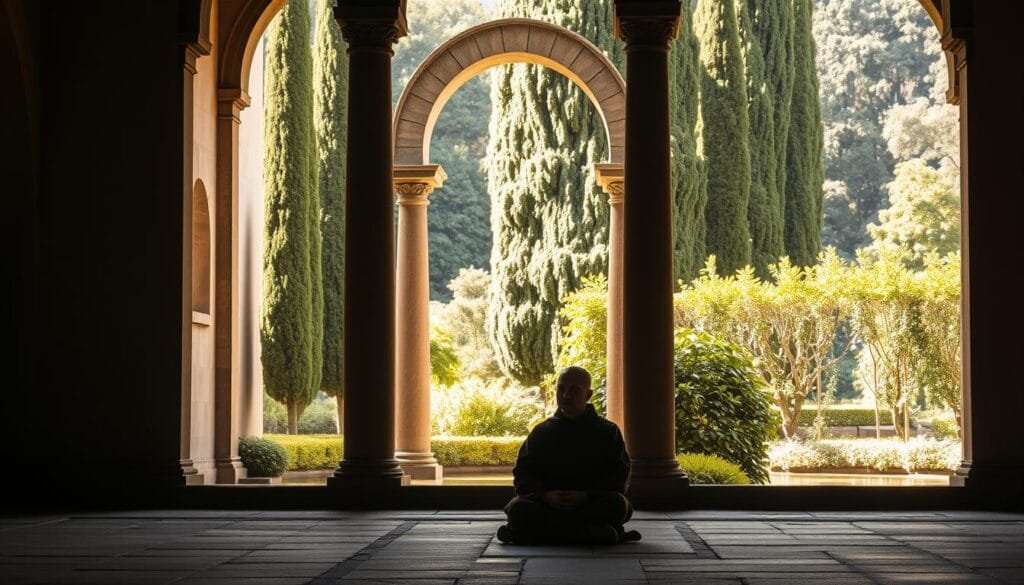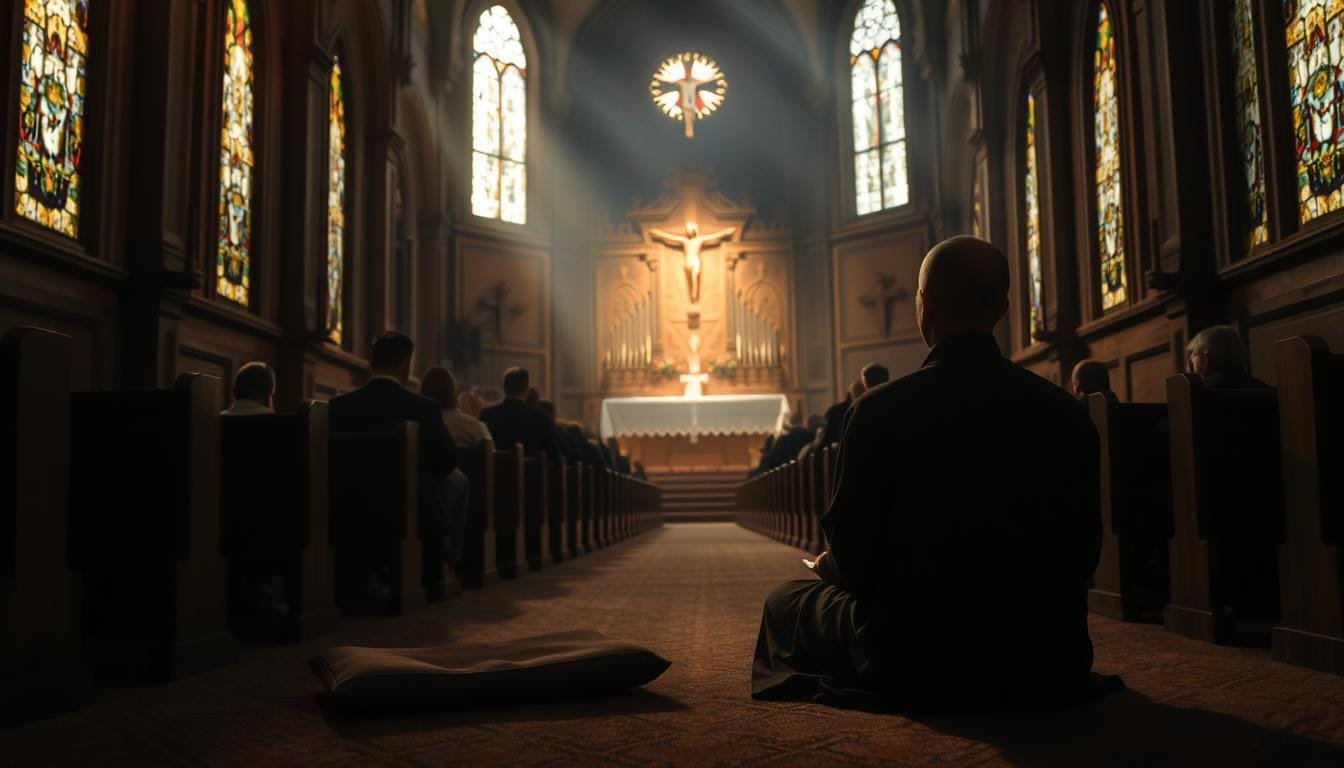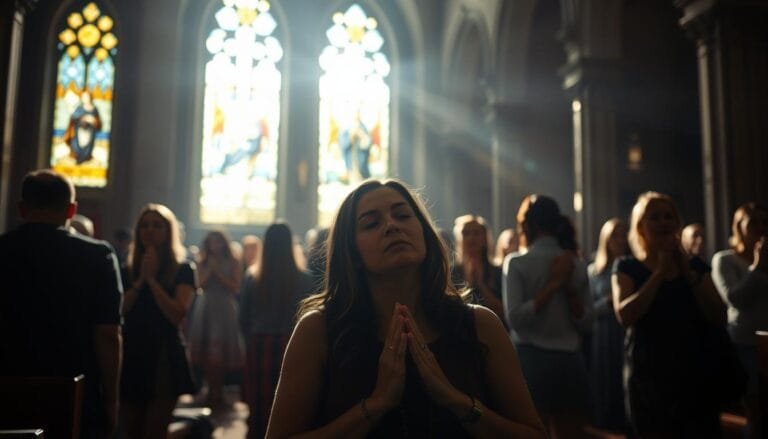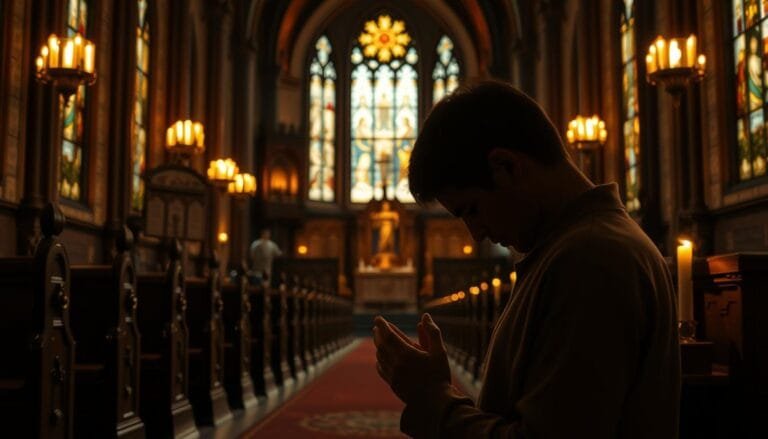Catholic Contemplative Silence
This website contains affiliate links. As an Amazon Associate, I earn from qualifying purchases. The content on this website was created with the help of AI.
Many of us struggle when we first try contemplative prayer. Just one minute of quiet can seem like an eternity. Yet, this silence is key to contemplative Catholic prayer.
Saints like St. Teresa of Calcutta found strength in quiet moments with God, even with a busy life.
The Catechism of the Catholic Church calls this prayer “silent love.” It mirrors Jesus’ 30 years of quiet before his public work.
Today, sacred silence offers a calm in our noisy world. Psalm 131:2 says, “As waters are stilled, so my soul is calm.”
Over 7 billion people seek peace, yet many Catholics miss this ancient practice. Simple steps like silent days or short retreats can help.
St. Mark’s Gospel reminds us: “At dawn, Jesus went to a lonely place” (Mark 1:35). Let’s discover how contemplative silence can change our faith journey.
Key Takeaways
- Catholic contemplative silence is a timeless practice rooted in Scripture and tradition.
- Contemplative prayer catholic deepens our relationship with God beyond spoken words.
- Saints like St. Teresa of Avila and St. John of the Cross model this discipline.
- Even brief daily pauses in sacred silence can quiet the “monkey mind” and renew hearts.
- This series guides readers in balancing modern life with the call to holy stillness.
Understanding Catholic Contemplative Silence
Contemplative prayer invites us to deepen our faith through sacred stillness. Let’s explore its roots and meaning.
The Catechism of the Catholic Church calls it “silence, the symbol of the world to come” (CCC 2717). This practice invites us to rest in God’s presence beyond words.
Defining Contemplative Prayer in Catholic Tradition
Catholic meditation silence is more than quiet reflection. It’s a wordless union with God, where we let go of thoughts to rest in His love.
Unlike meditation, which explores Scripture or ideas, contemplation is a gaze of the soul. As St. Teresa of Avila wrote, it’s like sharing a friend’s presence without speaking.
The Difference Between Meditation and Contemplation
| Meditation | Contemplation |
|---|---|
| Active reflection on Scripture | Passive reception of God’s love |
| Involves reasoning and analysis | Relies on trust and surrender |
| Uses guided thoughts | Empties the mind to meet God |
Both practices are vital. Catholic silent prayer practices begin with meditation, leading to contemplation’s stillness.
Imagine meditation as reading a letter from God—and contemplation as holding His hand in silence.
Scriptural Foundations for Sacred Silence
Scripture shows silence as holy ground. Elijah heard God in a “still, small voice” (1 Kings 19:12).
Jesus withdrew to pray in deserts and mountains (Mark 1:35. These moments modeled contemplative prayer catholic.
The psalms, too, teach this: “Be still, and know that I am God” (Psalm 46:10).
“If any man offend not in word, that same is a perfect man” (James 3:2. Silence guards our hearts from distractions.
Let’s nurture this gift of sacred stillness together. When we embrace silence, we align with Christ’s prayer life and grow closer to the divine.
The Rich History of Catholic Contemplative Silence
At the heart of catholic spiritual traditions is a long line of seekers. They turned to silence to meet God. The desert fathers and mothers of the 4th century started this journey in Egypt’s wilderness.
They practiced the desert fathers’ contemplative prayer. Their writings show a key truth: True silence starts when we quiet our inner noise.
“The mind must be still to hear God’s voice,” said Abba Poemen, a desert father whose wisdom still guides us today.
“Silence is the armor of the soul against the assaults of the devil,” — St. John Climacus

Monastic silence practices grew through communities like the Benedictines.
They made silence a part of daily life. St. Benedict’s Rule balanced work, prayer, and study, showing contemplation isn’t isolation but a path to intercession for all.
Later, medieval mystics like St. Teresa of Ávila deepened these teachings, calling contemplation “the marriage of the soul with God.”
| Era | Key Contribution | Figure/Order |
|---|---|---|
| 4th–5th Centuries | Foundational desert spirituality | St. Anthony, St. Syncletica |
| 6th Century | Monastic structuring of silence | St. Benedict |
| 16th Century | Mystical theology development | St. John of the Cross, St. Teresa of Ávila |
These traditions show us that contemplative prayer is alive today. We find quiet moments and join many believers who have found God in stillness.
Let their example inspire your own journey toward sacred listening.
The Spiritual Benefits of Embracing Holy Silence
Contemplative stillness takes us to a special place where God’s voice is clearer. It changes our hearts and minds in four key ways, rooted in faith.
Deepening Your Relationship with God

Quiet the mind to listen without words. The Catechism says silence lets God speak to our hearts.
A mother shared, “Being more patient and attentive, I felt God’s presence in everyday moments.” This catholic interior silence brings us closer to God, not just in prayer but in life.
Cultivating Interior Peace and Clarity
Science backs up what saints said: 70% of those who silently pray feel less anxious. It’s like a mental reset. St. John of the Cross said, “In silence, the soul finds its true home.”
Start with five minutes daily to find peace in a busy world.
“Solitude is a sacred place of silence where God has access to our inner being and soul.”
Strengthening Faith Through Silent Presence
Regular silence builds our spiritual strength. The USCCB suggests 15-30 minutes daily to deepen trust in God.
We see faith as a living bond by letting go of the need to “do” prayer. St. Teresa of Avila said, “Let nothing disturb you—quiet becomes a shield against life’s storms.”
Healing and Restoration in Sacred Stillness
Contemplative stillness heals wounded hearts. People find healing from past hurts in silence. A retreatant said, “In those quiet hours, I felt forgiveness flow like a river.”
It’s like Christ’s call to “come apart and rest” (Mark 6:31). Even 60 seconds a day can renew us.
Start with one minute of focused stillness today. Small steps in spiritual silence can lead to big changes. Your journey to contemplative stillness is unique—trust the Holy Spirit to guide you.
Catholic Contemplative Silence in Monastic Traditions
Monastic silence practices are rooted in ancient wisdom. They show how stillness can shape our spiritual growth. To learn more, visit monastic silence practices.
“Let us prefer nothing to the love of Christ,” wrote St. Benedict, revealing how silence creates space for God’s voice.
| Tradition | Practice | Focus |
|---|---|---|
| Desert Fathers | Wilderness retreats | Divine encounter |
| Benedictine | benedictine silence in daily rhythms | Listening to God |
| Carmelite | Carmelite contemplation | Union with God |
| Cistercian | Simple speech | Avoiding sin |
Each tradition offers a unique path. The Desert Fathers showed us how silence can clear distractions, and their wisdom guides us today.
Benedictine silence balances work and stillness through routines like Lectio Divina. Carmelite contemplation, as taught by St. Teresa of Avila, invites inner transformation.
Cistercians focus on simplicity, following Scripture’s advice to guard our tongues.
We can apply these lessons in our daily lives. Small steps, whether through daily pauses or prayer journals, help us grow in stillness.
Let these traditions inspire us to create sacred spaces for God’s presence in our lives.
Practical Steps to Incorporate Contemplative Silence into Daily Life
Imagine starting each day with just two minutes of stillness—a breath, a candle’s glow, and the quiet whisper of “Here I am, Lord.”
This simple practice grows into a daily contemplative practice that transforms rushed prayers into meaningful encounters with God.
Start by setting aside a corner of your home with an icon, crucifix, or candle to mark a sacred space. Even a kitchen windowsill or desk corner works.
- We are pleased to present James Brennan, a full line of hand-crafted crucifixes and crosses
- Known for his devout faith, keen understanding of the market and attention to the finest details, James Brennan has brou…
- These top of the line pieces are hand sculpted and cast in the United States using genuine lead-free pewter
Begin with five minutes of prayer and silence techniques. Sit comfortably, light a candle, and repeat a sacred word like “Abba” or “Maranatha.”
When thoughts interrupt, gently return to your anchor. Over time, extend sessions to ten or fifteen minutes. Remember: consistency matters more than duration.
A 2019 study found that even two-minute pauses improve emotional awareness and focus.
- Try “silent transitions”: pray in stillness during morning coffee, lunch breaks, or before bedtime.
- Share a moment of family silence at dinner or bedtime—children can light a candle and quietly hold hands.
- Use driving time or cooking as opportunities for Catholic silent prayer in daily life, focusing on breath or a chosen prayer word.
“Yes!” echoed through the Ocean City Youth Conference as 3,200 teens embraced a 15-minute silent reflection. Their response proves even the busiest lives crave stillness.
Begin with small steps. A parent might savor two minutes of silence during morning coffee. A student could pause between classes.
Thomas Keating’s Open Mind, Open Heart and contemplativeoutreach.org offer guides to deepen practice.
Let these moments of sacred stillness become a quiet rebellion against life’s noise—a space where God’s presence grows tangible, one breath at a time.
Overcoming Challenges in Your Contemplative Prayer Journey
Contemplative prayer challenges are part of the journey, not signs of failure.
When distractions arise or spiritual dryness in contemplation overwhelms, remember: even saints like St. Teresa of Ávila faced struggles. Let’s walk through practical steps to persevere.
“The key is to not give up and to offer up our time of prayer to God, seeking to hear his voice in the noise of our hearts.”
Addressing Common Distractions: A wandering mind or noisy environment need not derail your practice. Try these steps:
- Begin with short sessions (5-10 minutes) to build focus
- Use a simple prayer phrase like “Maranatha” to anchor your thoughts
- Keep a journal to track patterns and celebrate small progress
Moving Through Spiritual Dryness: Spiritual dryness contemplation can feel disheartening but is a shared experience.
St. John of the Cross called this the “dark night of the soul”—a phase of deepening trust. Try:
- Engaging with meditative Scripture passages like Psalm 46:10 (“Be still, and know that I am God”)
- Reading daily reflections to reignite faith
| Challenge | Solution |
|---|---|
| Time scarcity | Integrate 2-minute pauses during daily tasks |
| Feeling disconnected | Attend adoration chapel weekly for communal grounding |
Building consistency? Start with a “prayer buddy” accountability partnership. Remember: contemplative prayer challenges are not roadblocks but opportunities to surrender more fully to Christ’s presence.
As Thomas Merton wrote, “The desire to be hidden is itself a form of love.” Keep going—one breath, one moment at a time.
Conclusion: Embracing the Sacred Gift of Silence in Your Catholic Faith
Catholic contemplative silence is a real tradition waiting for us. It’s rooted in Scripture and followed by saints like John of the Cross.
This practice brings us peace and a deeper faith connection.
Our lives today are filled with constant noise. But, as Brother Michael found, quiet lets us hear God’s voice.
Saint John of the Cross taught that true growth comes from letting go of busyness. Even in tough times, silence leads us to God.
Start where you are. Even a few quiet moments can connect you to God. For more on living your faith, check out Catholic prayers of the faithful. Remember, silence is a choice to hear God’s whispers.
St. Augustine said our hearts rest in God alone. Let the wisdom of silence be your refuge.
Join those who’ve found faith grows in stillness, not noise. Start today, and let quiet be your strongest prayer.







